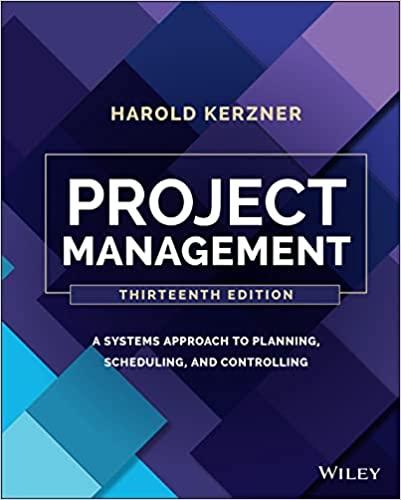Question
Harvey Westeen was a new human resources manager at a national truck parts distribution company. Each location had a warehouse and sales operation in the
Harvey Westeen was a new human resources manager at a national truck parts distribution company. Each location had a warehouse and sales operation in the same building. He could see that, while the company was successful, there was a wide range of management styles in evidence. Despite this, most locations ran well, while a few didn't seem to run quite so smoothly.
The warehouse operation in Calgary had an extremely high turnover rate. While moderate pay, benefits and working conditions were equivalent in the other locations across the country, turnover here was much higher. In particular, new warehouse employees were hard to retain. Often, they would leave within weeks of starting. At the time, recruitment in that city was very competitive, and the Manager spent most of his time replacing employees. An improved pay plan was initiated, but jobs were so plentifully, sometimes candidates would not even show up for interviews.
Obviously, retaining the employees they did hire was critical. The time spent filling gaps was excessive and drew the supervisors away from their roles constantly. The few lead hands they employed were also too busy picking orders, so they had no time to train the newcomers. To further complicate things, some of the existing staff were not reliable, so having them step up to train was out of the question.
While the warehouse worker job appeared straightforward, there were a number of complexities to it. A comprehensive system was required to stock, store and re-order the thousands of parts involved. Great care was needed when receiving and properly storing incoming parts, so they could be quickly accessed when ordered. In addition, "re-order points" needed to action when part stocks got low. Not locating the right part quickly caused massive delays, customer complaints and lost business. There were many other suppliers around. Scrupulous adherence to "the system" was essential and it took time to learn.
Fortunately, they had been able to hire a few "warehouse types". These were employees who enjoyed warehouse work, the systems involved and had experience in other warehouse/logistics operations.
One day, a Team Leader asked the Warehouse Manager, "Are you trying to fire that new kid you hired?" "No", was the answer. "Well, he's been doing nothing but tearing up cardboard boxes all week. The last three you assigned to that job quit!" Apparently, the new employees became bored with the routine tasks of tearing up boxes to recycle. They had no contact with others and received no actual supervision.
The issue was discussed by the Warehouse Manager, Branch Manager and Harvey. In the meantime, the employee was spoken to. He replied that as a newcomer, he knew he needed to "start at the bottom" and take on the less desirable tasks to start with. He was, however, interested in learning the rest of the operation. He was an experienced "warehouse guy". They developed a plan to address the range of issues they faced, hoping it would solve some problems.
First of all, they wanted to retain new employees, so developed a sequence of learning tasks, to orient and train them. This would enable them to work through a distinct "trainee position", a number of assignments in the first month on the job to begin learning the basics.
Secondly, they would still need some time tearing up boxes, but this would now be a rotating half-day assignment shared by others, during the quieter time of the week. There were no deadlines on this job, but they couldn't let it pile up either.
Finally, the job duties were changed so that other warehouse staff would rotate through those assignments and Departments to more effectively understand the impact of their work on the business.
They knew that the first month would be challenging, but felt this approach would hopefully, reduce the pressure by engaging and retaining new employees, broadening the knowledge of existing staff, building bench strength for internal replacements and contributing to smoother operations overall.
While this plan would initially put a great deal of pressure on them for the first few months, they felt that not changing would merely continue the problems they were currently having.
Address the three questions below (base your answers on course material AND on your personal experiences and sensibilities about workplaces):
- What does this tell us about the importance of job design?
- What would the changes to the wider Warehouse Worker position mean for those employees?
- What might be the implications (costs), for even the most junior of jobs, resulting from turnover related to poor job design?
Step by Step Solution
There are 3 Steps involved in it
Step: 1

Get Instant Access to Expert-Tailored Solutions
See step-by-step solutions with expert insights and AI powered tools for academic success
Step: 2

Step: 3

Ace Your Homework with AI
Get the answers you need in no time with our AI-driven, step-by-step assistance
Get Started


